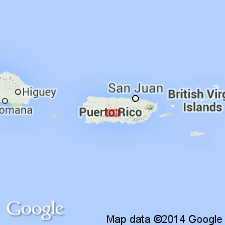
- Usage in publication:
-
- Achiote Conglomerate*
- Modifications:
-
- Named
- Dominant lithology:
-
- Conglomerate
- Sandstone
- AAPG geologic province:
-
- Caribbean region
Summary:
The Achiote Conglomerate, here named, consists of massive red volcanic conglomerate with interbedded green tuffaceous conglomeratic sandstone. Contains well-rounded clasts of red and green andesite and chert in a red mudstone matrix that contains feldspar and hematitic pellets. Conformably overlies Cotorra Tuff or Malo Breccia. Grades upward into Maravillas Formation. Is approximate stratigraphic equivalent of massive agglomerate facies of the Cariblanco Formation. Thickness is 200-400 m in southeastern Jayuya quad. and thickens westward to 1,800 m. Age is Santonian to Maastrichtian, perhaps in part as old as Coniacian based on gastropods and Foraminifera.
Source: GNU records (USGS DDS-6; Reston GNULEX).

- Usage in publication:
-
- Achiote Conglomerate*
- Modifications:
-
- Overview
- AAPG geologic province:
-
- Caribbean region
Summary:
The Achiote Conglomerate occurs in central Puerto Rico and consists of boulder and cobble conglomerate basalt and andesite clasts similar to the Jayuya Tuff, Vista Alegre Formation, and Cotorra Tuff. Lithologically similar sandstone and mudstone are interbedded. Maximum estimated thickness is 1800 meters. The Achiote is of Late Cretaceous age.
Source: GNU records (USGS DDS-6; Reston GNULEX).
For more information, please contact Nancy Stamm, Geologic Names Committee Secretary.
Asterisk (*) indicates published by U.S. Geological Survey authors.
"No current usage" (†) implies that a name has been abandoned or has fallen into disuse. Former usage and, if known, replacement name given in parentheses ( ).
Slash (/) indicates name conflicts with nomenclatural guidelines (CSN, 1933; ACSN, 1961, 1970; NACSN, 1983, 2005, 2021). May be explained within brackets ([ ]).

